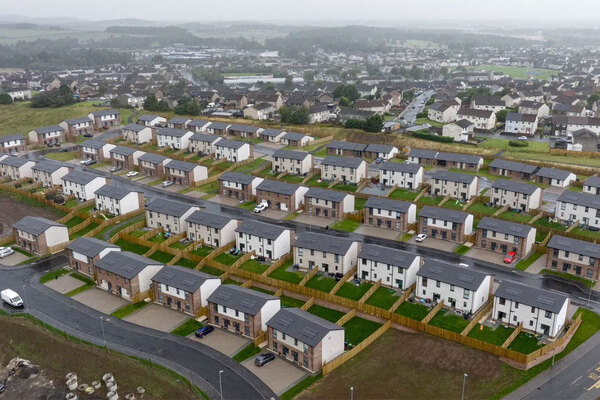You are viewing 1 of your 1 free articles
5 things we learned from Labour’s finalised NPPF
The government has published its finalised National Planning Policy Framework (NPPF). James Riding takes a look at some of the key points

Within three weeks of entering office, the Labour government opened a consultation on a new version of the NPPF which restored mandatory housing targets and set out a definition of ‘grey belt’ land.
The Ministry of Housing, Communities and Local Government (MHCLG) said: “The imperative of rapidly driving up planning consents in the context of a system with inadequate local-plan coverage will increase the number of permissions secured outside of plan allocations, but we are clear that there can be no trade-off between supply and quality.”
The final version of the framework keeps most of the proposals intact but includes some minor tweaks to housing targets and affordable housing requirements on green belt land. It also promises more clarity in the new year on how to identify grey belt land.
Inside Housing runs through five key things we learned.
Higher housing targets for London and the South East
The government will introduce a new standard method for calculating housing targets based on an area’s housing stock. In other words, councils will be tasked with delivering new homes that amount to a minimum of 0.8% of their area’s existing stock.
The target is then uplifted to reflect housing affordability pressures. This now means an affordability multiplier of 0.95 will kick in where house prices are five times median earnings.
The overall effect of these two changes is that housing need is reduced in more affordable areas and increased in areas where affordability problems are most acute, but overall remains around 370,000 nationally, the MHCLG said.
It results in increases in assessed housing need in London, the South East and East of England. For all other regions, housing need falls when compared with the method consulted on.
Local authorities can set their own green belt rules
The consultation proposed that any developments on green belt land must deliver at least 50% affordable housing, which some commentators suggested could be unviable in less expensive parts of the country.
“We note the concerns that setting a national 50% target could lack flexibility and fail to account properly for regional variation,” the MHCLG said.
For this reason, the government will allow local planning authorities to set their own golden rules in relation to affordable housing through their new local plans.
In the meantime, green belt development should deliver an amount of affordable housing that is 15 percentage points above the local affordable housing target, with a cap of 50%. In the absence of a pre-existing target for affordable housing, a 50% affordable housing target should apply by default.
More clarity on grey belt in January
The government has clarified that grey belt land is green belt land which does not “strongly contribute” to three purposes: to check the unrestricted sprawl of large built-up areas; to prevent neighbouring towns merging into one another; and to preserve the setting and special character of historic towns.
The revised grey belt definition will allow for development on land that is not already developed. However, “high-performing” green belt land should be protected, and previously developed land should be prioritised for development.
Councils will receive funding if they need to undertake green belt reviews to meet their new housing targets.
Ministers will also publish further guidance on green belt reviews in January 2025, to ensure a “more consistent approach to the identification of grey belt land”. This will assist in ensuring inappropriate or high-performing land is not identified for release or development, and will set out how the performance of green belt should be assessed.
This guidance will also focus on ensuring that parcels of land identified for development do not fundamentally undermine the purpose of the green belt.
Councils with old local plans must provide an extra year’s worth of homes
There were “many authorities” with local housing need figures substantially larger than their adopted or emerging local-plan housing requirement figures, the MHCLG said.
To help close the gap, authorities with plans adopted under the old method must provide an extra year’s worth of homes in their five-year housing pipeline.
Those authorities whose adopted plan housing target is 80% or less of their annual local housing need figure will be required to add a 20% buffer to their five-year housing land supply from 1 July 2026.
This will not be cumulative, so authorities that are already required to add a 20% buffer due to scoring below 85% in the most recent housing delivery test will not be required to add an additional buffer should they meet these criteria.
Transition period
The NPPF includes a short transition period for local authorities that are already well advanced with their local plans.
Under Labour’s original proposals, local plans that were published before examination (a stage known as Regulation 19) will be accepted as sufficient if their housing target is no more than 200 homes below the new calculation.
However, this has now changed to a percentage-based requirement. If the draft housing requirement meets less than 80% of local housing need, authorities will be required to update their plan to reflect the revised local housing need figure.
For authorities with plans at examination where the draft housing requirement meets less than 80% of local housing need, the authority will be expected to begin a plan in the new system as soon as it is brought into force in 2025.
Finally, there are also some changes to the proposed timings. The plan-making changes will take effect three months after the NPPF is published, to give local authorities more time to respond.
In addition, where plans at the Regulation 19 stage need to be updated to account for the revised NPPF and local housing need, the expectation for plans to be submitted in 18 months will be extended to December 2026.
All earlier-stage plans progressing under this version of the NPPF will be expected to be submitted for examination no later than December 2026.
Sign up for our development and finance newsletter
Already have an account? Click here to manage your newsletters










